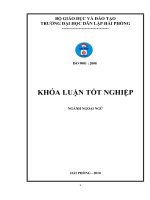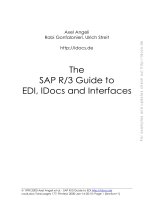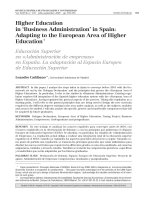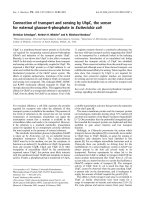The determinants for fresh graduates to select jobs and employers for intel vietnam master project in business administration
Bạn đang xem bản rút gọn của tài liệu. Xem và tải ngay bản đầy đủ của tài liệu tại đây (1.44 MB, 72 trang )
1
TRƯỜNG ĐẠI HỌC MỞ TP. HCM
HO CHI MINH CITY OPEN UNIVERSITY
UNIVERSITÉ LIBRE DE BRUXELLES
SOLVAY BRUSSELS SCHOOL
MBAVB3
VŨ THỊ HƯƠNG LAN
A Research on
THE DETERMINANTS FOR FRESH GRADUATES TO SELECT
JOBS AND EMPLOYERS
for Intel Vietnam
MASTER PROJECT
MASTER IN BUSINESS ADMINISTRATION
(PART-TIME)
Tutor’s Name: Dr. LÊ THÁI THƯỜNG QUÂN
Ho Chi Minh City
(2010)
2
DECLARATION
This thesis is a presentation of my original research work. Wherever
contributions of others are involved, every effort is made to indicate this
clearly, with due reference to the literature, and acknowledgement of
collaborative research and discussions.
The work was done under the guidance of Professor LE THAI THệễỉNG
QUAN, at the OPEN UNIVERSITY, HO CHI MINH CITY.
[Researchers name and signature]
VUế THề HệễNG LAN
3
ACKNOWLEDGEMENTS
Many remarkable people have contributed to this thesis in their guidance, support
and encouragement. Nevertheless, my special appreciation is for:
Doctor LE THAI THUONG QUAN, my principal supervisor, who has not only
supported me through this journey but also provided me with valuable academic
guidance.
Professor Michel VERSTRAETEN, whose human resource knowledge, theories
and materials added to the richness and academic contribution of my thesis
content.
Professor CLAIR GRUSLIN, whose market research teaching, books and
materials added to the richness and academic contribution of my thesis content.
Mr. BALAN KRISHNAN AMBIGAI, Staffing Manager of Intel Products
Vietnam and Malaysia, whose support me with deep and practical knowledge of
recruitment in Intel.
My husband and children, Thien An and Thien Phuoc, who through their prayers
and encouragement kept me focused and motivated, who have accompanied me
patiently in this journey.
5
TABLE OF CONTENTS
I.
Introduction ....................................................................12
1.1 Back ground and Intel Vietnam introduction ................................. 12
1.2 Problem statement .......................................................................... 13
1.3 Research objectives ........................................................................ 15
1.4 Scope of Research .......................................................................... 15
1.5 Thesis structure ............................................................................... 15
II.
Literature Review ............................................................................... 17
2.1 Importance of Recruitment & Selection in Human Resources .... 17
2.2 Human resource planning ............................................................... 18
2.3 Recruitment, Selection and Placement ......................................... 18
2.3.1 Definition of Recruitment ...................................................... 18
2.3.2 Definition of Selection ........................................................... 19
2.3.3 Definition of Placement ......................................................... 19
2.4 Recruitment theories for Semiconductor Manufacturing .............. 19
2.4.1 Classical Control Theory ........................................................ 20
2.4.2 Rough Set Theory for Semiconductor Manufacturing .......... 21
2.4.3 Job satisfaction, Motivation & Recruitment Challenges ....... 21
2.4.4 Behling and other’ theories of Recruitment .......................... 23
III.
Research Methodology - Hypotheses - Questions -: .............................. 26
3.1 Research Methodology .................................................................. 26
3.2 Research Hypotheses ..................................................................... 26
3.3 Research Questions ........................................................................ 27
6
3.4 Main issues ...................................................................................... 27
3.5 Questionnaire design ...................................................................... 28
3.5.1 Content of questionnaire ........................................................ 28
3.5.2 Format of questionnaire ......................................................... 29
3.5.3 Layout of questionnaire .......................................................... 29
3.6 Sampling method. ............................................................................ 30
3.6.1 Population ............................................................................... 30
3.6.2 Sample selection ..................................................................... 30
3.7 Survey Instrument ........................................................................... 31
IV.
Research results and findings: .................................................................. 33
4.1 Sample characteristics .................................................................... 33
4.1.1 Major ...................................................................................... 33
4.1.2 Gender ..................................................................................... 34
4.1.3 Grade Point Average (GPA) .................................................. 35
4.1.4 Education Level & Degree .................................................... 35
4.1.5 English skill ............................................................................. 36
7
4.2 The key expectations of fresh graduates ...................................... 38
4.2.1 Job Major expectation ............................................................ 38
4.2.2 Compensation & Benefits expectation .................................. 39
4.2.3 Career Opportunity expectation ............................................. 39
4.2.4 Working Environment expectation ........................................ 40
4.2.5 Company Reputation expectation .......................................... 40
4.2.6 Overall conclusion and ranking all expectations ................... 41
4.3 Detailed Analysis top three expectations....................................... 41
4.3.1 Working Environment elements & ranking ........................... 42
4.3.2 Compensation & Benefit elements & ranking ..................... 43
4.3.3 Career Opportunity elements & ranking ............................... 44
4.4 Testing for difference in ranking expectations by segments ......... 44
4.4.1 Ranking top 3 expectation elements by Education Level .... 45
4.4.2 Ranking top 3 expectation elements by Gender ................... 51
4.4.3 Ranking top 3 expectation elements by Major ...................... 55
4.5 Perception of Fresh Graduates about Company Reputation ......... 58
4.6 Preferable channels of Fresh Graduates ....................................... 59
4.8 Knowledge about Intel of Fresh Graduates ................................... 60
4.9 Fresh Graduates’ ideas to improve Intel knowledge .................... 61
V. Conclusion, discussion and recommendations .............................................. 62
5.1 Conclusion and Discussion ............................................................. 62
5.2 Recommendations ........................................................................... 63
5.2.1 Apply expectation analysis for marketing & benefit policy. 64
8
5.2.2 Promote Intel image and opportunity information ................ 64
5.2.3 Diversify job post channels .................................................... 65
5.2.4 Revise expectation to utilize local labor pool ....................... 65
5.2.5 Higher education support policy for fresh graduates ........... 65
5.2.6 Promote attractive and transparent career path..................... 66
5.3 Limitations ..................................................................................... 66
References List ................................................................................................... 67
Appendix: Questionaire ...................................................................................... 68
9
LIST OF ABBREVIATIONS
1.
C&B: Compensation and Benefits
2.
CO: Career Opportunity
3.
CR: Company Reputation
4.
HR: Human Resources
5.
IT: Information Technology
6.
GPA: Grade Point Average
7.
M&E: Mechanical and Electrical
8.
PR: Publish Relation
9.
RC: Role Centrality
10. Sig.: Significance Level
11. SPSS: Statistical Package for the Social Sciences
12. WC: Work Centrality
13. WE: Working Environment
14. B.S.: Bachelor of Science
10
LIST OF TABLES
Table 4.1 : Sample distribution by Major ............................................................. 33
Table 4.2 : Sample distribution by Major versus Gender .................................... 34
Table 4.3 : Sample distribution by GPA ............................................................... 35
Table 4.4 : Sample distribution by Education Level ............................................ 35
Table 4.5 : Crosstab ” English Skill & Education Level ...................................... 37
Table 4.6 : Working Environment Elements ........................................................ 36
Table 4.7 : The most importance of Working Environment by Education Level 46
Table 4.8 : The most importance of C&B by Education Level ........................... 47
Table 4.9 : Salary Expectation for Bachelor by Education Level ....................... 49
Table 4.10 : The most importance of Career Opportunity by Education Level .. 51
Table 4.11 : The most importance of Working Environment by Gender ............ 52
Table 4.12 : The most importance of C&B by Gender ........................................ 53
Table 4.13 : The most importance of Career Opportunity by Gender ................. 54
Table 4.14 : The most importance of Working Environment by Major............... 56
Table 4.15 : The most importance of Compensation & Benefits by Major ........ 57
Table 4.16 : The most importance of Career Opportunity by Major ................... 58
11
LIST OF FIGURES
Figure 2.1: Model of Engineering Education pathway ........................................ 20
Figure 4.1: Sample distribution by Major ............................................................. 34
Figure 4.2: Sample distribution by Gender ........................................................... 34
Figure 4.3: Sample distribution by GPA ............................................................... 35
Figure 4.4: Sample distribution by Education Level ............................................ 36
Figure 4.5: Overall about English Skill of sample................................................ 36
Figure 4.6: Importance Level of a Job at Major ................................................... 38
Figure 4.7: Importance Level of Compensation & Benefits ................................ 39
Figure 4.8: Importance Level of Career Opportunity .......................................... 39
Figure 4.9: Importance Level of Working Environment ...................................... 40
Figure 4.10: Importance Level of Company Reputation...................................... 40
Figure 4.11: Importance Level of five Key Expectations .................................... 41
Figure 4.12: The most importance of Working Environment ............................. 42
Figure 4.13: The most importance of Compensation & Benefits ....................... 43
Figure 4.14: The most importance of Career Opportunity .................................. 44
Figure 4.15: Education Level & Salary Expectation for Bachelor ..................... 48
Figure 4.16: Company Reputation ........................................................................ 59
Figure 4.17: Preferable Channels to seek jobs ..................................................... 60
Figure 4.18: Intel Perception ................................................................................. 60
Figure 4.19: Fresh Graduates’ ideas to improve Intel knowledge....................... 61
12
CHAPTER I
INTRODUCTION
This chapter provides an overview of Intel Global, its investment to Intel
Vietnam and its hiring need. A brief introduction to the young talent pool of Ho
Chi Minh City is mentioned in the chapter, the research problem, core objectives,
scope of the study and structure of the research report.
1.1 Background and Intel Vietnam Introduction
Intel Corporation is a technology company, and the world's largest semiconductor
chip maker. Intel also makes motherboard chipsets, network interface controllers
and integrated circuits, flash memory, graphic chips, embedded processors, and
other devices related to communications and computing. Intel combines
advanced chip design capability with a leading-edge manufacturing capability.
Originally known primarily to engineers and technologists, Intel's "Intel Inside"
advertising campaign of the 1990s made it and its Pentium processor household
names.
During this period Intel became the dominant supplier of microprocessors for
PCs. The 2010 rankings of the world's 100 most powerful brands published by
Millward Brown Optimor showed the company's brand value at number 48.
The company is headquartered in California's Silicon Valley and has operations
around the world. Outside of California, the company has facilities in Argentina,
China, Costa Rica, Malaysia, Mexico, Israel, Ireland, India, Philippines, Poland,
Russia, and Vietnam internationally.
Intel has a Diversity Initiative, including employee diversity groups based on
race and nationality as well as sexual identity and religion.
13
Intel has taken a giant step into Vietnam as the first and largest major foreign
investor in high technology by investing US$1 billion in a semiconductor
assembly and test facility at Saigon Hi-Tech Park in Ho Chi Minh City.
1.2 Problem statement
The production of Intel Products Vietnam needs thousands of young technicians,
engineers and bachelors who have good engineering, business and English skill.
Recruiting qualified fresh students for the Company is the goal of the recruiting
team. Data shows that annually, about 50,000 students graduate from more than
fifty universities in Ho Chi Minh City. Potential skillful students account for
about 70% of them. However English communication is a highest barrier for
Vietnamese students. A sample survey on English language skill among
university graduates that do not major in languages found 51.7 per cent did not
use English for research or communication purposes. Most students were not able
to use the language to study, do research or even communicate after learning at
universities for up to six years. A recent survey conducted by the Law University
in Ho Chi Minh City reported only 1 per cent of its students held an advanced
English-language degree. Around 80 percent of students are at beginner or
primary levels. The principal of The Hanoi Trade University said the graduates
were able to get between 400 and 450 on the TOEIC test (Test of English
International Communication) while an employee in Intel must have an English
capability equivalently to 500 or higher.
As a result, the potential candidate number is decreased significantly to around
20 per cent of the total graduates nowadays, given about 10,000 potential
candidates available for thousands of organizations in Ho Chi Minh City. In
particular, the combined effects of increased demand and smaller supply will
14
increase the competition among organizations over available qualified labor
pool. Therefore, the high potential candidates often receive many attractive job
offers from employers, especially multinational companies where the
management trainee programs are conducted such as Unilever, Siemens, Sam
Sung, Hongkong Shanghai and Banking Corporation…. These students are quite
selective when identify ideal employers to start their career and devote their
enthusiasm.
In the coming years, Intel intends to expend to 4,000 employees from the current
500 employees. The size of the factory also increases more than ten times from
one production chain currently. The human resource department of Intel has
working out that in three years, the company will need an around 2,000
manufacturing technician and engineers at bachelor degree or college diploma.
Utilization of fresh and qualified student is a priority of Intel since with huge
demand of new employees. The Company will hire up to 70% of the employees
directly from universities, fresh graduates (both Engineers and Business students)
and provide them with specific trainings to meet the company’s requirements.
Experienced candidates are not much in the market and are usually not willing to
change job or take part in re-training sessions. Good and fresh graduate students
have been considered the best choice for the company to develop its workforce.
Though understanding the importance of new and fresh graduates in the work
force of Intel, it is actually not an easy task to attract these students to work for
Intel. In addition, Intel requests for good and qualified students, which is
considered a strict demand under the conditions that Vietnamese universities’
training program is not catch up with the high technical industry.
15
1.3 Research Objectives
The research therefore will survey the determinants that affect the employer
selection or job expectation of fresh graduates and last year students. From these
factors, Intel might develop corporate marketing activities and adjust its
recruitment policy to be more attractive to these students.
1.4 Scope of Research
Although there are many external factors coming from family, economic crisis or
unemployment which may impact to the employer and job selection of the target
group, the research will focus on the impacts come from the target group’s side
only.
The research will not extend to students and fresh graduates from the universities
out of Ho Chi Minh City or those who have higher or lower education which are
not mentioned in the target group criterion. Experienced or non-Vietnamese
candidates and those who are not qualified with the criterion mentioned above
are also excluded from the research.
1.5 Thesis structure
This study report is presented in five chapters as follow:
Chapter 1 - Introduction provides a brief introduction to the young talent pool of
Ho Chi Minh City, overview of Intel Vietnam and its hiring need, the research
problem, core objectives, scope of the study and structure of the research report.
Chapter 2 - Literature Review provides some conceptual definitions of human
resource planning, Recruitment ” Selection - Placement, theories of Recruitment
and Job Expectation. Also it reports several literature reviews of Job Satisfaction
and
Motivation
Manufacturing.
trend
and
Recruitment
Challenges
in
Semiconductor
16
Chapter 3 - Research Methodology introduces the research model, hypotheses,
questions and issues. This chapter would cover the general approach and
construct measurement of the study, the source of desk research to be used, data
collection method including the design of questionnaire and sampling method.
Chapter 4 ” Research Results and Findings presents the description of the sample
and response rate of the survey, the practical assessment the relationship among
the variances by Crosstab - SPSS, results of Chi-square Test toward various
hypotheses, resulting a clear picture of the target group ‘s expectation and
behaviors when seeking job and choose employers. .
Chapter 5 - Conclusion, Discussion and Recommendations summarizes and
discusses the key findings of the research, then suggests recommendations for
improving hiring rate, Intel corporate branding and policy to attract the target
group.
17
CHAPTER II
LITERATURE REVIEW
The objective of this chapter is to review the relevant concepts about
Recruitment, Sourcing Plan. The researcher studies many recruitment theories
about Job Seekers’ Motivation and Expectation. The literature specifically
relating to current situation of high technology recruitment and challenges
nowadays is studied in this part also. The recruitment theory and the trend of the
target applicants’ behaviors will help the researcher to identify the focus points to
carry out the research.
2.1 The importance of Recruitment and Selection in Human Resources
Human resources management occupies the prime position of all disciplines in
management which deals with many resources. According to Adam Smith, these
were land, labor, capital. In the present nuclear age and globalization, it may be
appropriate to expand the scope of resources further and show them under the
following three broad classification:
“Humanware
“Infoware, and
“Orgoware
In these definition of resources, we find human beings playing a dual role - a
resource as well as a motive force for all other resources by way of developing,
utilizing, commanding and controlling them like materials, machines, money,
information, land infrastructure, etc. In the fast changing world of globalization,
successful industries are becoming ‚knowledge based‛ and ‚skilled incentive‛. It
is possible by developing ‚creative spirit‛ in employees and employing
18
‚innovative management techniques‛. Both these are possible only through
empowerment of employees. Empowerment is possible when employees are
competent, take interest in their work, become committed to organization and
employers in turn, trust them fully.
2.2 Human resources planning:
According to DeCenzo and Robbin, Human Resources Planning is very important
for the organization because it can help the organization making sure that it has
enough staff to implement its program activities. Moreover, it helps human
resources department to determine what qualification and skill set the company
need and how to place those selected candidates in the right positions, at the right
time. According to Byars and Rue, 2004, human resources planning is not only
the responsibility of human resources manager alone to handle, but also the duty
of all line managers. The role of HR staffing team will work as consultant to
other line managers, to assist them developing their departmental plan and then
consolidate those plans into organizational human resources planning for the long
term strategy.
2.2 Recruitment, Selection and Placement
2.3.1 Definition of Recruitment
Noe, Hollenbeck, Gerhart and Wright, 2007 have mentioned that human
resources recruitment is a continuous process conducted by the organization in
order to identify and attract potential employees. The main purpose of
recruitment is to source more personnel within the limited resources of time,
recruiting consultants and budget.
The recruitment activities will impact the number and type of applicants. Refer to
recruitment channels, beside internal, we also have many external channels such
19
as employee referral, on-line or newspaper job advertisement, hiring events and
job fairs. According to Byars and Rues, 2004, employee referral has been the
most effective source.
2.3.2 Definition of Selection:
According to Byars and Rue 2004, selection is the process of choosing the best
and qualified candidates from the available applicants that are most fit and likely
to perform the job successfully. The employee selection is different from one
organization to another. It depends on the job scope, job type and the culture of
the organization. Selection process consists of screening resumes and application
forms, preliminary interview, employment testing, physical examination, followup interviews and reference checking.
2.3.3 Definition of Placement:
Placement is finding the appropriate set of knowledge, skills and abilities which
come packaged in a human being, is an attempt to get a match between what the
applicant can and wants to do and what the organization needs. This fit reflects
both the employer’s willingness to make an offer and the applicant to accept the
job. In other words, fitting a person to the right job, at the right time is called
placement.
2.2Recruitment theories for Semiconductor Manufacturing
Modern organizations place must attend to the recruitment and selection of highpotential talent, since the human capital is the key to success in a knowledgebased economy. For the semiconductor industry, the requirements for personnel
quality are strict in order to catch up the trend for technology advance and
migration following Moore‘s law
20
2.4.1 Classical Control Theory: Modeling Undergraduate Engineering
Recruitment.Camelia L. Owens and Norman L. Fortenberry 2006 used Classical
Control Theory to proposed a model of the engineering education pathway from
middle school through high school and through the completion of the B.S. degree
in engineering. The model incorporates the closed-loop infrastructure of earlier
models of Grismore and Sheppard Models and extends the feedback control
loops which characterize external recruitment efforts.
Figure 2.1: Model of Engineering Education pathway
(Camelia L. Owens and Norman L. Fortenberry 2006)
The model aims to improve the number of B.S. engineers produced through a
direct feedback loop and explores other locations of the feedback.
21
2.4.2 Rough Set Theory to recruit high-potential talents for Semiconductor
Manufacturing
Chen-Fu Chien 2007 developed an effective historical data mining approach
based on Rough Set Theory to explore and analyze human resource data for
personnel selection effectiveness, to extract rules between applicants’ profiles
and their work behaviors. It is important to identify effective recruitment
channels and the right screening criteria to select the right talents. The input
attributes at the selection stage include demographic data such as age,
educational background, work experience, job function and the recruitment
channel through which they applied.
2.4.3 Job satisfaction and motivation trend & challenges of recruitment:
In today's marketplace, where companies seek a competitive edge, satisfaction
and motivation are keys for talent attraction and retention. No matter the
economic environment, the goal is to create a workplace that is engaging and
motivating, where employees want to join, stay, grow and contribute their
knowledge, experience and expertise.
Satisfaction:
The exit of important and valuable human resources from the organizations
leads to the loss of the tacit knowledge possessed by the leavers, as a result of
the high cost of filling the positions that are vacant. The concept of tacit knowing
comes from scientist and philosopher Michael Polanyi. Hence, turnover negates
the benefit that should have been derived by organisations when they spend
scarce resources attracting, selecting, socialising employees, and developing and
retaining performing employees (Wright & Bonett 2007). Wright and Bonett
(2007) tested the interactive effect of one individual factor, psychological well
being, and found a significant interactive effect on the Job Satisfaction turnover
22
relationship. These authors also recognised the existence of other individual
factors that are potential antecedents of employee turnover: work centrality
(WC) and Role centrality (RC). Earlier, Carlson and Kacmar (2000) called that
WC focuses on the centrality of the entire work system. The focus is on the
centrality of the current role an individual is playing in the work place. Role
centrality (RC) is thus, defined as the importance of the current role of an
individual to the individual's identity. Paullay, Allinger and Stone- Romero
(1994) stated that job involvement should be defined in relation to the current
job of the individual, and not confounded with general work involvement.
Similarly Mossholder, Settoon and Henagan (2005:609) defined a micro
centrality, network centrality as "... relative numbers of direct and indirect links
an
individual
has
with
others
comprising
a
social
network".
. Recently Trevor (2001) redefined these components to include economic and
individual factors. Akerele, et al. 2007, identified three additional pathways to
employee turnover, namely, through the interactive effects of Life Satisfaction
(which is affected by job and family satisfaction) and Role Centrality (Job
involvement).
Motivation:
The human resources department within an organization, years ago known as
the "personnel department," manages the administrative aspects of the
employees. Nowadays HR professionals seek to support their organizations by
attracting and retaining the best and brightest talent. Motivational theories can
offer insight into how to motivate employees:
* Expectancy Theory is about choice. It explains the processes that an individual
undergoes to make choices. In organizational behavior study, expectancy theory
is a motivation theory first proposed by Victor Vroom of the Yale School of
Management. : Victor H. Vroom's theory suggests that motivation is high when
23
employees believe that high levels of effort lead to high performance and high
performance
leads
to
attainment
of
desired
outcomes.
* Maslow's Hierarchy of Needs: People seek to satisfy five basic needs:
physiological, safety, belongingness, self-esteem and self-actualization needs.
Abraham Maslow Abraham (Harold) Maslow (April 1 1908 ” June 8 1970) was
an American psychologist. He is mostly noted today for his proposal of a
hierarchy of human needs and is considered the father of humanistic psychology,
who placed these needs in a pyramid, with the most basic on the bottom and
self-actualization at the top. When the lower-level needs are met, the next
higher level begins to motivate behavior.
* Herzberg's Motivator-Hygiene Theory: This theory from Frederick Herzberg
Frederick Irving Herzberg (1923 - 2000) is a noted psychologist who became
one of the most influential names in business management. He is most famous
for introducing job enrichment and the Motivator-Hygiene theory. focuses on
two factors applicable to the workplace:
1) Basic expectations (hygiene factors Hygiene factors are job factors that can
cause dissatisfaction if missing but do not necessarily motivate employees if
increased[1]. Hygiene factors have mostly to do with the job environment [2]. )
2) Motivation factors: leading to increased performance. Examples of basic
needs are:
- a comfortable working environment,
- an adequate pay,
- good relationships with co-workers and effective supervision,
- opportunities for recognition, advancement and professional growth.
2.4.4 Behling and others’ Theories of Recruitment
As per Behling and others, there are three ways in which an individual make a
decision to join an organization: objective factor, subjective factor and critical
24
contact. These are briefly discussed here as under:
(a) Objective Factor Theory:
As per this theory the choice of organization by a potential employee depends
on objective assessment of certain tangible factors, such as the following:
“ Pay and perks.
“ Location.
“ Opportunity for career growth.
“ Nature of work
“ Educational opportunities, etc.
(b) Subjective Factor Theory:
According to this theory compatibility of individual personality with the image
of organization is a decisive factor in choosing an organization by an individual
candidate seeking employment
(c) Critical Factor Theory:
there are instances when a candidate is unable to choose an organization, out of
alternatives based on objective or subjective factors which are given above. This
is due to many reasons such as limited contact and insufficient data, in regards to
the organization or his inability to analyze and come to any firm conclusion. In
such cases, certain critical factors observed by him during his interview and
contact with personnel of the organization will have profound influence in his
decision process.
It must be remembered that the theoretical base given above, is developed by
Behilng and others was mostly influenced by the labour conditions which exist in
developed countries like USA and western European nations like UK, France,
and Germany. In these countries vacancies are plenty and there is scarcity of
suitable hands. In developing nations, the reverse is the case, where vacancies
are less and hands are more resulting large scale ‚educated unemployment‛.
25
The theoretical base given above as such cannot be applied in conditions expect
in high paid jobs like R&D, marketing, finance, etc, where higher skill and
better knowledge are the prerequisites. In such cases candidate has variety of
choices and he is the master of his choice.
26
CHAPTER III
RESEARCH METHODOLOGY ” HYPOTHESIS - QUESTIONS
3.1Research Methodology
Learning from Behling‘s Objective Factor Theory and Herzberg's MotivatorHygiene Theory, the researcher began with a desk research, analyzing Intel’s
internal recruitment databases containing information about job candidates, job
descriptions, screening results, interviews and selections.... The researcher also
searched for information related to job seekers’ behavior via the Internet,
available magazines and job reports and the literature review mentioned above.
The researcher then organized a focus group of ten targeted candidates to
indentify the expectation trend of the population in order to draft out some
hypotheses to study.
Then a quantitative research was launched to 300 last year students and fresh
graduates who are selected as the sample for the population mentioned in the
sample part. This is a descriptive, quantitative and causal research, to understand
not only what the target group expect as an overview but also classify them into
segments, analyze how they select elements and rank the respective expectations
and concerns.
3.2 Research Hypotheses
These hypotheses include:
1. Intel may not catch the trend of target group’s expectation about the
employers and jobs
2. The graduates from different groups have different job-seek behaviors and
expectation
3. Intel is not high evaluated in the job market









